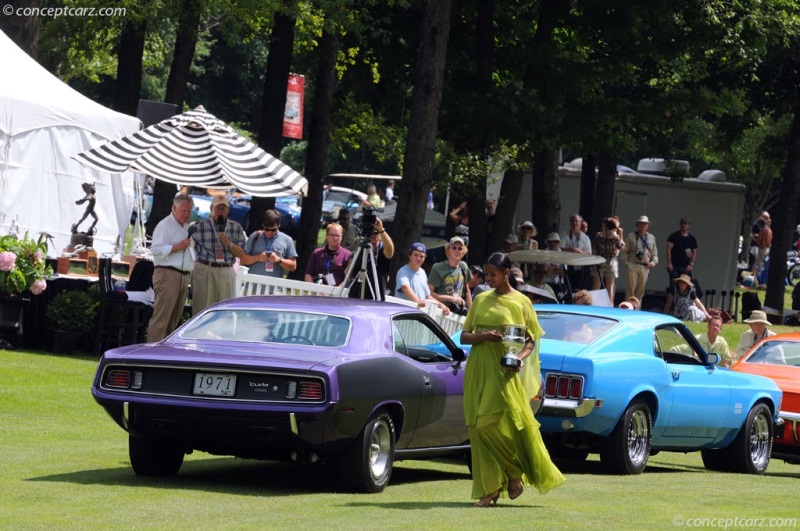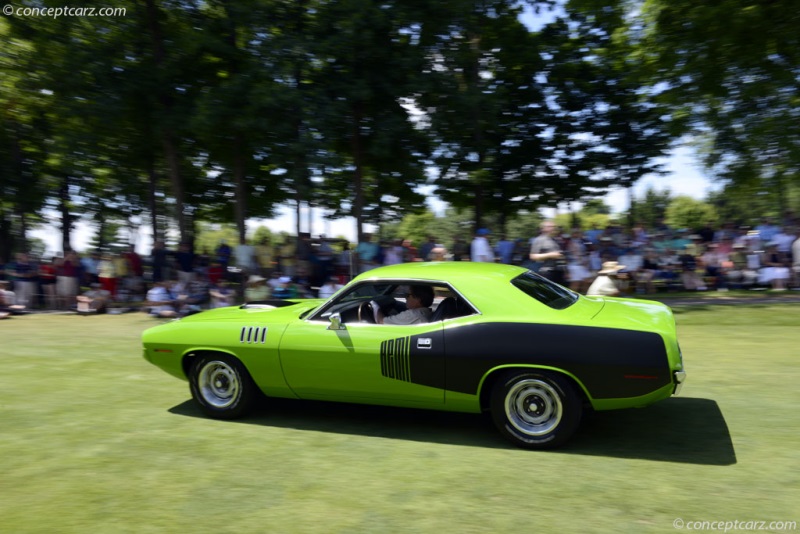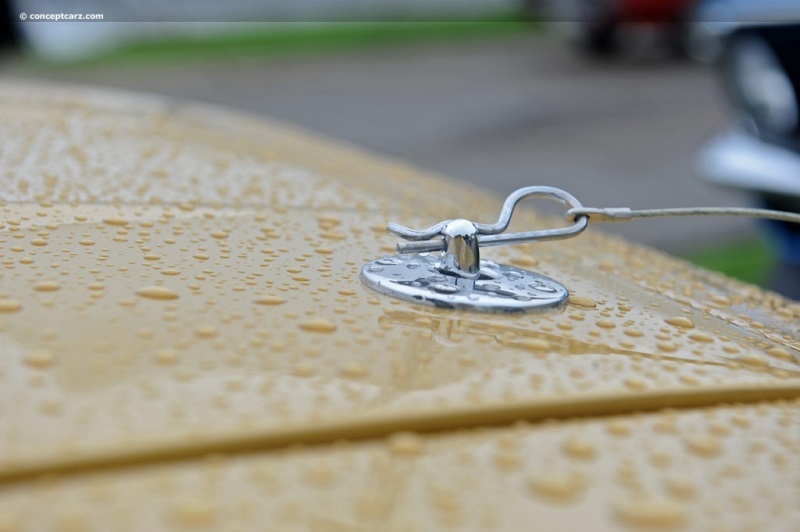The redesigned Plymouth 'E-Body' Barracuda was introduced in late-1969 for 1970 and was designed to accommodate the entire Chrysler engine line. The performance-oriented 'Cuda version was finally available from Chrysler dealers with the 426 Street Hemi for 1970. The dual quad engine produced an understated 425 horsepower and allowed skilled drivers to clock 13-second quarter-mile ETs. Barracuda HistoryThe Chrysler Corporation's Plymouth Division had beaten archrival Ford to market by two weeks with the introduction of its Barracuda fastback for 1964, however, sales of the compact Valiant-based Plymouth lagged far behind those of the Ford Mustang and later Chevrolet Camaro. As early as 1965, design and development work commenced on a new Barracuda and its Dodge Division stablemate, with styling led by John Herlitz and fine-tuned by Carl Cameron. By 1968, prototypes were created followed by additional fine-tuning as Chrysler executives and product planners were fully committed to achieving perfection, devoting generous amounts of time and resources to the E-Body program. Targeted at the performance car market, the E-Body Barracuda and Dodge Challenger were aimed at the upper market, while the new Plymouth Duster and Dodge Demon fastbacks plus Dodge's Dart notchbacks covered the lower spectrum. Although the arrival of the E-Body Plymouth Barracuda and Dodge Challenger coincided with the fast-approaching end of the American muscle car era, they assumed 'instant legend' status thanks to the sleek and aggressive styling, and the combination of personal car with muscle car performance. 1971 would be the Hemi Cuda's swan song, retiring in its second and final year as unchanged as the engine itself; both disappeared into history as the model year wound down.The 1970 Plymouth BarracudaThe new Barracuda was offered in standard and luxury Gran Coupe guises, and the more aggressive 'Cuda (the name derived from the 1969 option). Now based on the E-body platform, it shed all previous commonality with the Valiant, dropped the fastback design, and was now offered in coupe and convertible body styles. Compared to the existing B platform, it was both shorter and wider, and was used to carry the newly launched Dodge Challenger and Barracuda. Similarities ended there, as the Challenger's 110-inch wheelbase was 2-inches longer than its Barracuda sibling and neither shared any exterior sheet metal. The body of the Challenger was five inches longer than the Barracudas. The performance-minded consumer was pleased with the larger size of the E-body's engine bay, compared to that of the previous A-body, as it could house Chrysler's 426 CID (7.0 Liter) Hemi. The standard Barracuda engine was a 225 cubic-inch version of the inline 'Slant' six, joined by two V8 displacement sizes of 318 (two barrel), and a 383 (with two or four-barrel carbs). Power choices for the 'Cuda ranged from the standard 383 cubic-inch V-8 to the optional 375-hp 440, 390-hp (385 hp for 1971) V-Code 'Six Barrel' triple-carb unit and 426 Street Hemi. The ability to house the vast assortment of Chrysler engines was courtesy of the front sub-frame and rear-suspension assemblies sourced from the larger and equally versatile Chrysler B-body line. This setup provided an aggressive track and the ability to use the new, wider, low-profile tires available by 1969. The impressive handling and ride quality were courtesy of longitudinal torsion bars up front and a live rear axle supported by tuned leaf springs.Prior Barracudas were made available to select racing teams with Hemi power in 1968, but since they were not equipped with a full exhaust system, and lacked federally mandated safety equipment for road use, they were never publicly available from Plymouth dealerships. The arrival of the E-Body Hemi 'Cuda as a regular factory option allowed anyone (with appropriate financial resources) to purchase a factory-built five-passenger racing car. The 1971 Plymouth Barracuda
Cuda Convertible
Chassis #: BS27N 1B234 130
View info and history
Auction entries : 1The 1971 style was largely consistent with the previous year's design, with revisions confined to bright front-fender louvers, a more aggressive grille, and the availability of bold 'billboard' graphic accents on the rear flanks with stylized lettering announcing the engine's displacement. The optional shaker hood scoop (available with the 340, 383, 440 four-barrel, 440 six-barrel, and 426 Hemi engines) was now painted flat black to address glare issues. 1971 was the only year during E-Body production that the 'Cudas had fender-mounted louvers and quad headlights. This was also the final year for the Barracuda convertible, with 1,385 examples built. Overall Barracuda production declined from 54,800 units in 1970 to 18,690 units in 1971. Standard equipment included hubcaps, bucket seats, cigar lighter, defroster, heater, fuel, temperature, and ammeter gauges. There were brake warning lights (taillamps and backup lights were now individual units), day/night inside mirror, and a left outside rearview mirror. Plymouth introduced a Coupe (A93) body style in mid-year 1970 and built through the 1971 model year. It came with a standard 198 CID Slant Six engine, fixed quarter glass (compared to roll-down windows), and a lower-grade interior. 
Cuda Convertible
Chassis #: BS27N 1B234 130
View info and history
Auction entries : 1The Gran Coupe added leather bucket seats, overhead consolette, formed headliner, and pedal trim. The exterior received Gran Coupe ornamentation, and wheel lip and belt moldings. Only eight-cylinder power could be found in the engine bay of the Gran Coupe. The performance 'Cuda came standard with the 383 CID four-barrel V8, heavy-duty suspension and brakes, whitewall tires, and 'Cuda ornamentation. Along with items found on the standard and Gran Coupe, they received a special 'performance' hood with integral scoops, a black-finished rear deck panel, a color-keyed grille, and chrome rocker sill moldings. 198 CID Slant Six and 225 CID Slant Six
The 198 cubic-inch Slant Six inline engine, available on the coupe, had solid valve lifters, a cast iron block, overhead valves, four main bearings, 8.4:1 compression, a bore of 3.4 inches, and a stroke of 3.64 inches. With a single-barrel carburetor, the engine delivered 125 horsepower at 4,000 RPM. The 225 cubic-inch inline-6 engine had a 3.40-inch bore, the same as the 198 CID six but with a larger stroke of 4.125 (compared to 3.64 inches). It had a cast iron block, 8.4:1 compression, solid valve lifters, four main bearings, a Carter Type BBS two-barrel carburetor, and delivered 145 hp at 4,000 RPM.
Cuda Convertible
View info and history383 and 340 CID
Plymouth's 440 and 426 V-8-equipped 'Cudas offered more performance, while the 383 and 340 were lighter and far less expensive. Only the 383 and the 340 'Cuda are fitted with rear stabilizers, allowing them to maneuver corners with greater ease.The base 'Cuda came with a 383 cubic-inch engine which had a 4.25-inch bore, a 3.375-inch stroke, 9.5:1 compression, overhead valves, a cast iron block, a Carter four-barrel carburetor, and delivered 335 horsepower (SAE gross) at 4,800 RPM (the same output as Dodge's 383 Magnum). The 340 cubic-inch V8 had a 4.04-inch bore, 3.31-inch stroke, 10.3:1 compression, five main bearings, and hydraulic valve lifters. The AAR 'Six-Pack' with triple 2-barrel carburetors produced 290 hp.The four-barrel 'Cuda 340 CID V8 was $44 and the four-barrel 383 CID V8 was $140 in 1971 (The six-barrel 340 was not offered in 1971). The 383-2V produced 275 hp (SAE Gross) in 1971 and the 383-4V version delivered 300 hp (SAE Gross).
Cuda Hard Top Coupe
View info and historyThe 440 Big Block
The 440 big-block was optional in four-barrel super commando and 'Six Pack' triple-carburetor super commando configurations. Its bore measured 4.25 inches and its stroke at 3.75 inches. It had a cast iron block, hydraulic valve lifters, five main bearings, 9.7:1 compression, a four-barrel carburetor, and delivered 375 hp at 4,300 RPM. The 440 triple two-barrel Super Commando Six Pack had a gross rating of 390 hp. The 1971 440-6V produced 385 hp (SAE Gross) - the four-barrel carbureted 440 V8 engine was not on the 1971 options list (although, it could be purchased via special order and it is believed that as many as twelve were so-equipped). Interestingly, the 440 Six-Barrel 'Cuda was easier to maintain, tune, and offered at a much lower price with similar performance figures to its Hemi counterpart. Both 440 and Hemi-powered cars were equipped with standard high-performance underpinnings including rear leaf springs (at no additional cost). The Street Hemi
The price of the Hemi 'Cuda complemented its performance for 1970, demanding an $871 premium over the basic 'Cuda's $3,164 starting price. This exclusive option added a 'Shaker' hood scoop (N96) with 'hemi cuda' callouts and color-matched to the grille, no-cost heavy-duty underpinnings, and a cheese-grater grille, front fender inserts, Cuda emblems, chrome rocker moldings, and through-valance bright exhaust tips.
Convertible
Chassis #: BH27C1 B126595
View info and history
Auction entries : 1The 426 Street Hemi, updated for 1970, received a maintenance-free hydraulic camshaft retaining the same lift and duration specifications as the old solid-lifter unit. It had header-style cast-iron exhaust manifolds, efficient hemispherical cylinder heads, and dual inline Carter four-barrel carburetors. The heavy-duty four-speed manual transmission cost a further $194, and Chrysler's console-mounted 'Slap Stik' A-727 TorqueFlite automatic transmission was another excellent drivetrain choice.The 426-8V produced 425 hp (SAE Gross) in 1971. 652 'Cuda hardtops and 14 convertibles were built for 1970 with Hemi power, and 107 hardtops and 12 convertibles (as few as 11 - with five of those slated for non-U.S. destinations). Of the 107 Hemi 'Cuda hardtops built in 1971, thirteen were originally equipped with billboard decals.
Convertible
Chassis #: BH27C1 B126595
View info and history
Auction entries : 1Optional Equipment
The A34 Super Track Pak code came with the D32 heavy-duty A727 automatic transmission and a Dana 60 differential featuring Sure Grip and a 4.10:1 ring and pinion. A34 also meant B51 power front disc brakes and maximum cooling equipment. The A33 Track Pak added a 26-inch radiator, seven-blade viscous fan and Hemi suspension upgrades.Option code A21 were front-only elastomeric (rubber) colored bumpers and code A22 were a front and rear combination. The Spicer-built Dana 60 rear axle with a 9.75-inch ring gear was optional with the automatic transmission and standard with manual transmission and 440 six-barrel and 426 Hemi engines. Styling options included hood modifications, decal sets, and 'high impact' colors that consisted of 'Sassy Grass', 'Moulin Rouge', 'Lime Light', 'Tor Red', 'Lemon Twist', 'Curious Yellow', 'Vitamin C', 'Bahama Yellow', and 'In-Violet'.Hood pins, standard on the 'Cuda, cost $15, dual outside, color-keyed racing mirrors (left remote-control) were $26, and bodyside tape stripe was $29. When ordered on the Gran Coupe, the tape stripe replaced the paint stripe. Power steering was an additional $97, the automatic transmission was $209, the four-speed manual was $198, and powerside windows were $101. The powerlift convertible top was $49. The AM/FM radio with stereo and tape added $337 to the base price, and the Microphone tape recorder was an $11 option. A vinyl roof was an $82 option. Price and ProductionThe 1971 Barracuda two-door coupe (A93) was the 198 CID Slant Six engine was priced at $2,650, a two-door hardtop coupe with the standard six-cylinder engine was priced at $2,765; the addition of the standard 383 CID V8 boosted the price to $2780 for the former and $2,865 for the latter. The convertible was priced at $3,025 ($3,124 with V8). 9,459 examples of the combined coupe and hardtop coupe were built and 1,014 of the convertibles.
Cuda ConvertibleThe Barracuda Gran Coupe was priced at $3,030 and 1,615 examples were constructed. 6,228 buyers selected the 'Cuda hardtop coupe at a base price of $3,160 and 374 buyers opted for the $3,410 convertible. E-Body production continued through the 1974 model year. 1971 was the final year that Plymouth offered the Barracuda with Big Block engines (the 383, 440, and 426 Hemi). Engine options for 1972 included the 225 six, the 318, and a revised 340 CID V8. All three were revised and detuned to run on no-lead (low) gas. As automakers complied with new safety and emission regulations, the Baraccuda received bumpers that met federal impact standards, and popular performance parts were removed from the options list including the heavy-duty suspensions and rear axles, along with the larger and wider tires wrapped on the 15-inch x 7-inch wheels. 1971 was the final year for the Barracuda convertible (albeit, a few 1971 convertibles were updated with 1972 grilles and back panels to be used on TV and movie sets). MotorsportsIn the Super Stock and the new heads-up Pro Stock professional stock racing class, the HEMI 'Cuda dominated from 1970 through 1972 in the hands of racers including Sox & Martin until NHRA weight penalties eroded the Hemi's advantage. Dan Gurney's All American Racers campaigned the 'Cuda in small-block form, spawning a unique 'Cuda AAR version for the street. Swede Savage and Dan Gurney competed with identical factory-sponsored AAR 'Cudas during the 1970 Trans-Am season with the highest finish being second place at Road America. In nitro-burning Funny Car competition, blown Hemis powered tube-chassis, fiberglass-bodied copies of the 'Cuda's body to six-second glory, especially from the two-car 'Snake and Mongoose' team of Don Prudhomme and Don McEwen running under Mattel 'Hot Wheels' sponsorship. Other well-known 'Cuda AA/Funny Car teams included California's 'Big John' Mazmanian, and Dunn & Reath. In international competition, Chrysler France campaigned four Hemi-powered cars in circuit races and hill climbs.
by Daniel Vaughan | Jan 2023

Cuda Convertible
Chassis #: BS27N 1B234 130
View info and history
Auction entries : 1
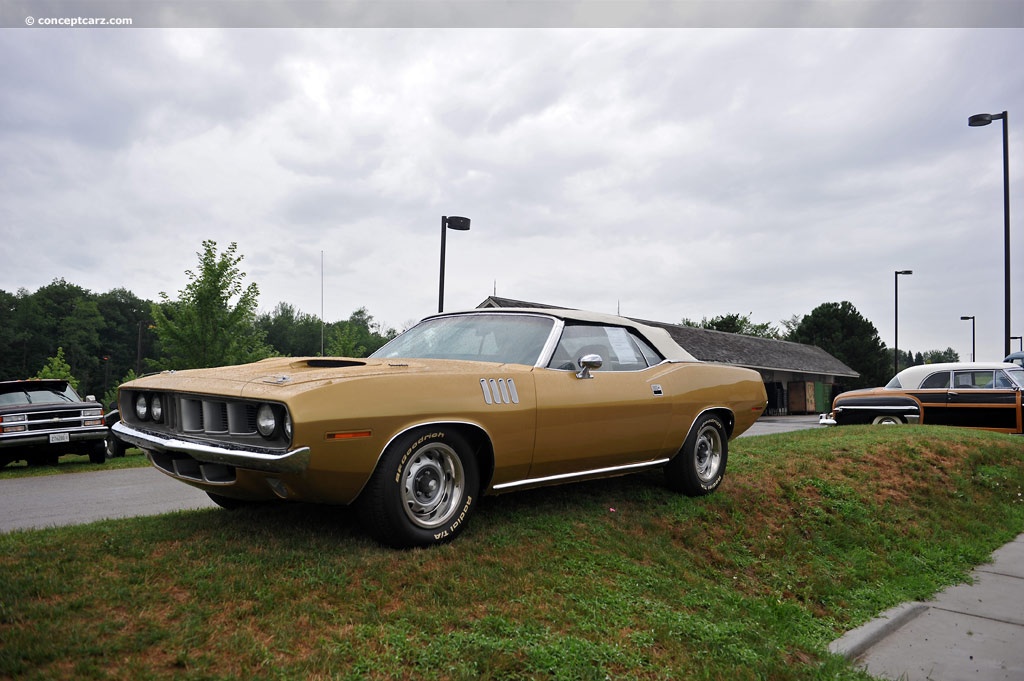
Cuda Convertible
Chassis #: BS27N 1B234 130
View info and history
Auction entries : 1
The 198 cubic-inch Slant Six inline engine, available on the coupe, had solid valve lifters, a cast iron block, overhead valves, four main bearings, 8.4:1 compression, a bore of 3.4 inches, and a stroke of 3.64 inches. With a single-barrel carburetor, the engine delivered 125 horsepower at 4,000 RPM. The 225 cubic-inch inline-6 engine had a 3.40-inch bore, the same as the 198 CID six but with a larger stroke of 4.125 (compared to 3.64 inches). It had a cast iron block, 8.4:1 compression, solid valve lifters, four main bearings, a Carter Type BBS two-barrel carburetor, and delivered 145 hp at 4,000 RPM.
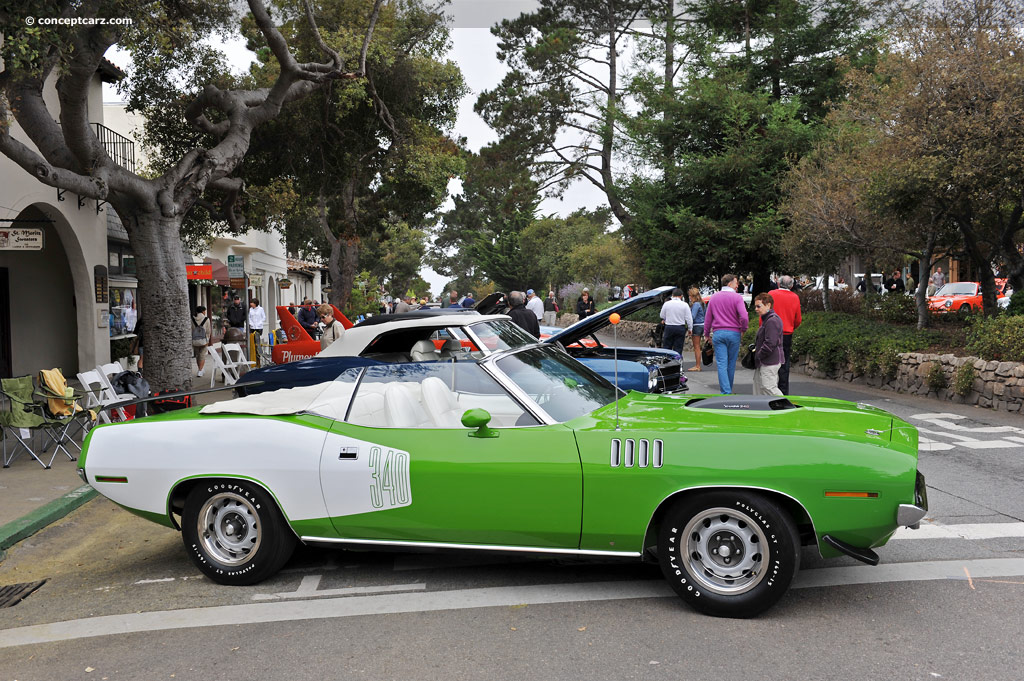
Cuda Convertible
View info and history
Plymouth's 440 and 426 V-8-equipped 'Cudas offered more performance, while the 383 and 340 were lighter and far less expensive. Only the 383 and the 340 'Cuda are fitted with rear stabilizers, allowing them to maneuver corners with greater ease.The base 'Cuda came with a 383 cubic-inch engine which had a 4.25-inch bore, a 3.375-inch stroke, 9.5:1 compression, overhead valves, a cast iron block, a Carter four-barrel carburetor, and delivered 335 horsepower (SAE gross) at 4,800 RPM (the same output as Dodge's 383 Magnum). The 340 cubic-inch V8 had a 4.04-inch bore, 3.31-inch stroke, 10.3:1 compression, five main bearings, and hydraulic valve lifters. The AAR 'Six-Pack' with triple 2-barrel carburetors produced 290 hp.The four-barrel 'Cuda 340 CID V8 was $44 and the four-barrel 383 CID V8 was $140 in 1971 (The six-barrel 340 was not offered in 1971). The 383-2V produced 275 hp (SAE Gross) in 1971 and the 383-4V version delivered 300 hp (SAE Gross).
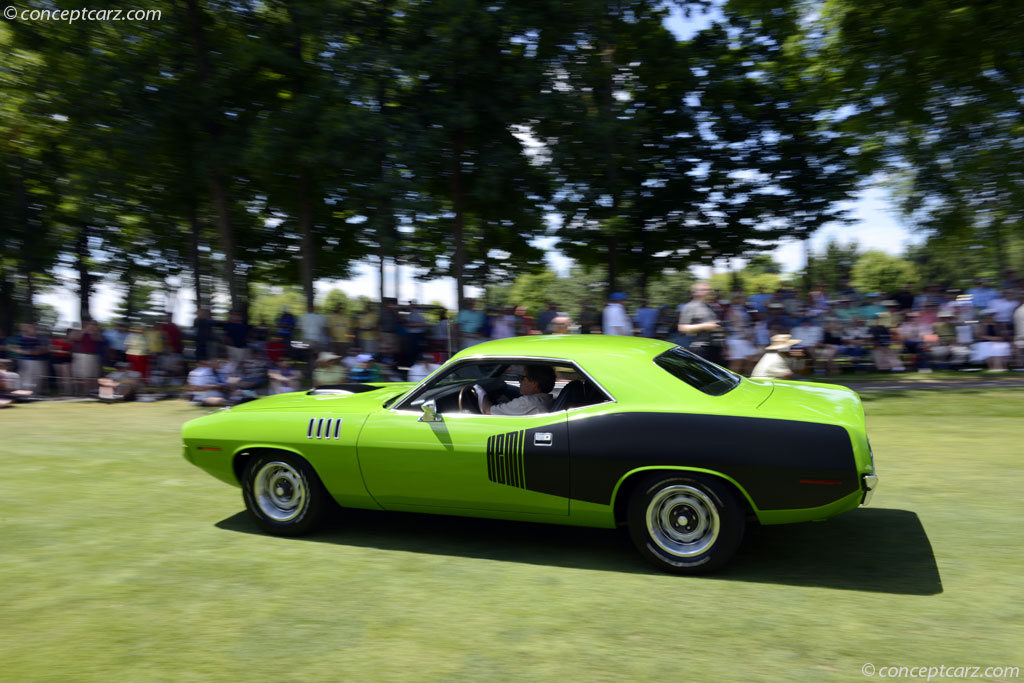
Cuda Hard Top Coupe
View info and history
The 440 big-block was optional in four-barrel super commando and 'Six Pack' triple-carburetor super commando configurations. Its bore measured 4.25 inches and its stroke at 3.75 inches. It had a cast iron block, hydraulic valve lifters, five main bearings, 9.7:1 compression, a four-barrel carburetor, and delivered 375 hp at 4,300 RPM. The 440 triple two-barrel Super Commando Six Pack had a gross rating of 390 hp. The 1971 440-6V produced 385 hp (SAE Gross) - the four-barrel carbureted 440 V8 engine was not on the 1971 options list (although, it could be purchased via special order and it is believed that as many as twelve were so-equipped). Interestingly, the 440 Six-Barrel 'Cuda was easier to maintain, tune, and offered at a much lower price with similar performance figures to its Hemi counterpart. Both 440 and Hemi-powered cars were equipped with standard high-performance underpinnings including rear leaf springs (at no additional cost). The Street Hemi
The price of the Hemi 'Cuda complemented its performance for 1970, demanding an $871 premium over the basic 'Cuda's $3,164 starting price. This exclusive option added a 'Shaker' hood scoop (N96) with 'hemi cuda' callouts and color-matched to the grille, no-cost heavy-duty underpinnings, and a cheese-grater grille, front fender inserts, Cuda emblems, chrome rocker moldings, and through-valance bright exhaust tips.
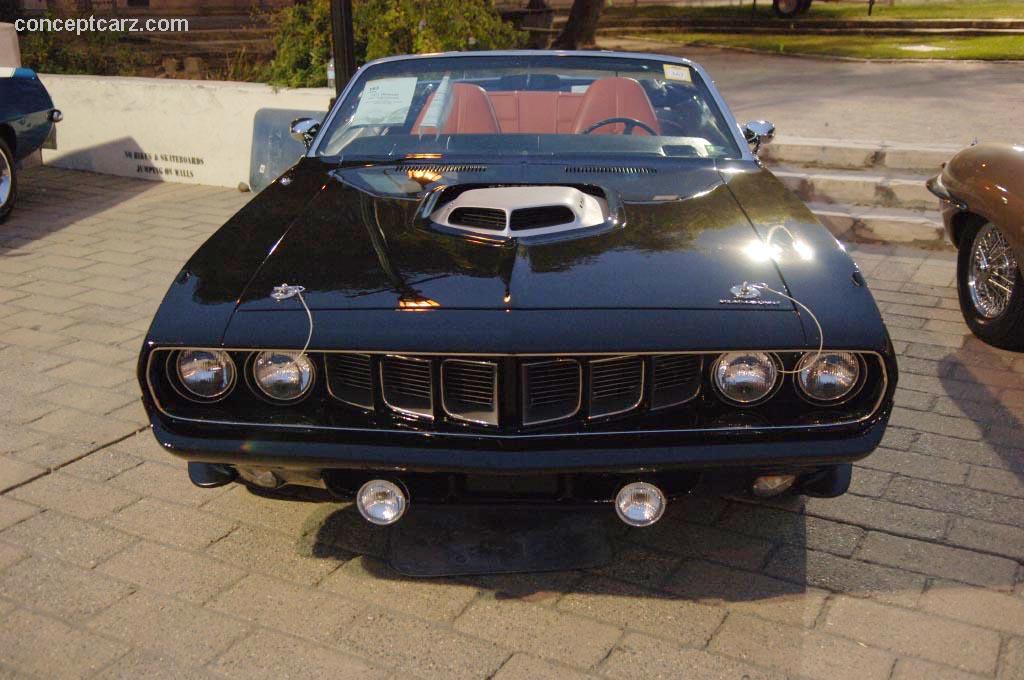
Convertible
Chassis #: BH27C1 B126595
View info and history
Auction entries : 1
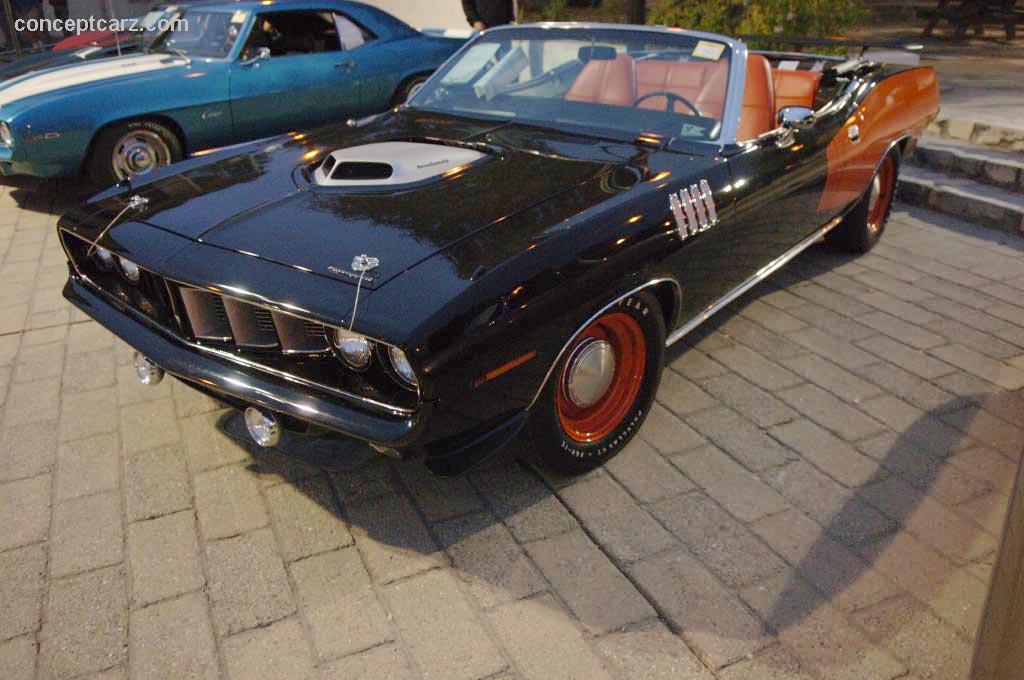
Convertible
Chassis #: BH27C1 B126595
View info and history
Auction entries : 1
The A34 Super Track Pak code came with the D32 heavy-duty A727 automatic transmission and a Dana 60 differential featuring Sure Grip and a 4.10:1 ring and pinion. A34 also meant B51 power front disc brakes and maximum cooling equipment. The A33 Track Pak added a 26-inch radiator, seven-blade viscous fan and Hemi suspension upgrades.Option code A21 were front-only elastomeric (rubber) colored bumpers and code A22 were a front and rear combination. The Spicer-built Dana 60 rear axle with a 9.75-inch ring gear was optional with the automatic transmission and standard with manual transmission and 440 six-barrel and 426 Hemi engines. Styling options included hood modifications, decal sets, and 'high impact' colors that consisted of 'Sassy Grass', 'Moulin Rouge', 'Lime Light', 'Tor Red', 'Lemon Twist', 'Curious Yellow', 'Vitamin C', 'Bahama Yellow', and 'In-Violet'.Hood pins, standard on the 'Cuda, cost $15, dual outside, color-keyed racing mirrors (left remote-control) were $26, and bodyside tape stripe was $29. When ordered on the Gran Coupe, the tape stripe replaced the paint stripe. Power steering was an additional $97, the automatic transmission was $209, the four-speed manual was $198, and powerside windows were $101. The powerlift convertible top was $49. The AM/FM radio with stereo and tape added $337 to the base price, and the Microphone tape recorder was an $11 option. A vinyl roof was an $82 option. Price and ProductionThe 1971 Barracuda two-door coupe (A93) was the 198 CID Slant Six engine was priced at $2,650, a two-door hardtop coupe with the standard six-cylinder engine was priced at $2,765; the addition of the standard 383 CID V8 boosted the price to $2780 for the former and $2,865 for the latter. The convertible was priced at $3,025 ($3,124 with V8). 9,459 examples of the combined coupe and hardtop coupe were built and 1,014 of the convertibles.
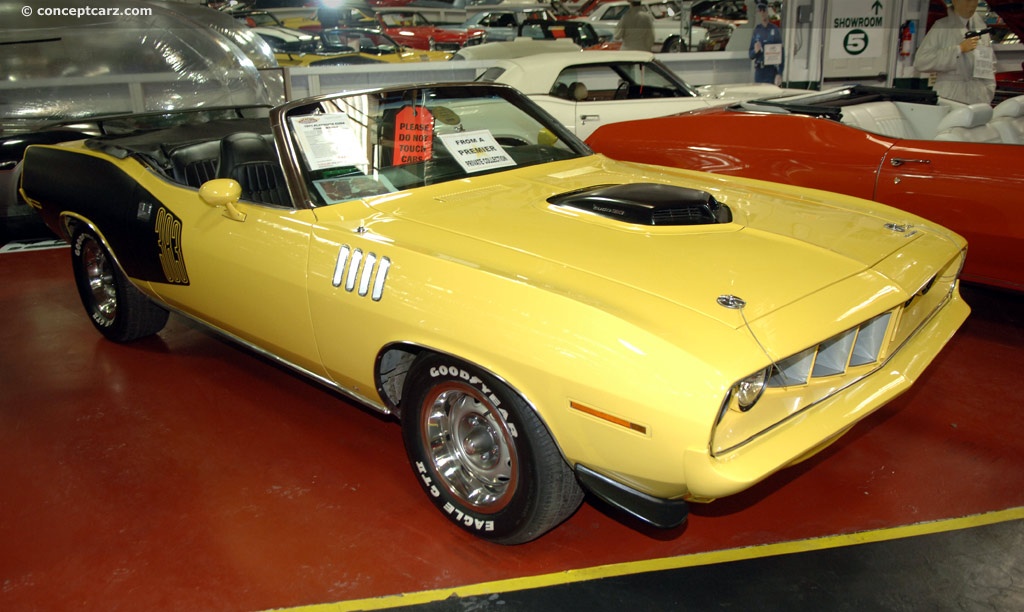
Cuda Convertible
by Daniel Vaughan | Jan 2023
Related Reading : Plymouth Barracuda History
The first series of the Barracuda was produced from 1964 through 1969, distinguished by its A-body construction. From 1970 through 1974 the second series was produced using an E-body construction. In 1964, Plymouth offered the Barracuda as an option of the Valiant model line, meaning it wore both the Valiant and Barracuda emblems. The base offering was a 225 cubic-inch six-cylinder engine that....
Continue Reading >>
Continue Reading >>
Similarly Sized Vehicles
from 1971
1971 Plymouth Barracuda Vehicle Profiles
Recent Vehicle Additions
Performance and Specification Comparison
Price Comparison
$2,310 - $2,700
$2,660 - $3,640
$3,110 - $4,145
$3,730
Barracuda (Third Generation) Specification Comparison by Year
Year
Production
Wheelbase
Engine
Prices
108.00 in.
6 cyl., 225.00 CID., 145.00hp
8 cyl., 318.00 CID., 230.00hp
8 cyl., 383.00 CID., 335.00hp
8 cyl., 440.00 CID., 375.00hp
8 cyl., 426.00 CID., 425.00hp
8 cyl., 318.00 CID., 230.00hp
8 cyl., 383.00 CID., 335.00hp
8 cyl., 440.00 CID., 375.00hp
8 cyl., 426.00 CID., 425.00hp
$2,760 - $3,430
18,690
108.00 in.
6 cyl., 198.00 CID., 125.00hp
6 cyl., 225.00 CID., 145.00hp
8 cyl., 318.00 CID., 230.00hp
8 cyl., 340.00 CID., 275.00hp
8 cyl., 383.00 CID., 275.00hp
8 cyl., 383.00 CID., 300.00hp
8 cyl., 440.00 CID., 385.00hp
8 cyl., 426.00 CID., 425.00hp
6 cyl., 225.00 CID., 145.00hp
8 cyl., 318.00 CID., 230.00hp
8 cyl., 340.00 CID., 275.00hp
8 cyl., 383.00 CID., 275.00hp
8 cyl., 383.00 CID., 300.00hp
8 cyl., 440.00 CID., 385.00hp
8 cyl., 426.00 CID., 425.00hp
$2,660 - $3,410
18,450
108.00 in.
6 cyl., 198.00 CID., 100.00hp
8 cyl., 318.00 CID., 150.00hp
8 cyl., 340.00 CID., 240.00hp
8 cyl., 318.00 CID., 150.00hp
8 cyl., 340.00 CID., 240.00hp
$2,710 - $2,950
22,213
108.00 in.
8 cyl., 318.00 CID., 150.00hp
8 cyl., 340.00 CID., 235.00hp
8 cyl., 340.00 CID., 235.00hp
$2,940 - $3,125
11,734
108.00 in.
8 cyl., 318.00 CID., 150.00hp
8 cyl., 360.00 CID., 245.00hp
8 cyl., 360.00 CID., 245.00hp
$3,065 - $3,250
Related Automotive News

Newport Car Museum Adds Eight New Cars for June 1 Anniversary
PORTSMOUTH, R.I. (May 27, 2019) – The Newport Car Museum in Portsmouth, R.I. will celebrate its second anniversary on June 1 with eight new additions to its private collection of over 75 rare, stunning and exotic cars.
At first we were adding...

INCREDIBLE HEMI POWER ROLLS INTO THE WORLD'S LARGEST COLLECTOR-CAR AUCTION
Two Hemi Cuda Convertibles and a Hemi Challenger RT Convertible Headline 31 Hemi-Powered Mopars on Offer at Mecum Kissimmee 2016
Walworth, Wis. – Dec. 22, 2015 – One Plymouth Hemi Cuda Convertible is a big deal. Two are a really big...

1970 PLYMOUTH HEMI CUDA CONVERTIBLE WILL STAR AT MECUM MONTEREY 2015
The Executive Demonstrator of John Herlitz is a Rare Treasure
WALWORTH, Wis. – Aug. 4, 2015 – While the famous Monterey Car Week is typically associated with multimillion-dollar purebred European sports cars and antique luxury auto...

Thomas Scott Collection of Classic American Automobiles to be On Offer at No Reserve at Russo and Steele's 2015 Monterey Collector Automobile Auction Event
Scottsdale, Arizona (July 18th, 2015) – Thomas Scott is an accountant and entrepreneur from Athens, Georgia who has had a love for all things automotive for as long as he can remember. He possesses a lifetime of passion for buying, selling and...

Russo and Steele Collector Automobile Auctions Kicks Off 15th Anniversary with Eight Initial Offerings to Watch
Scottsdale, Arizona (December 1st, 2014) – For Enthusiasts – By Enthusiasts. ™ This is far more than a tagline at Russo and Steele Collector Automobile Auctions. Its a lifestyle, and we are gearing up to deliver that singular passion to the High...





























